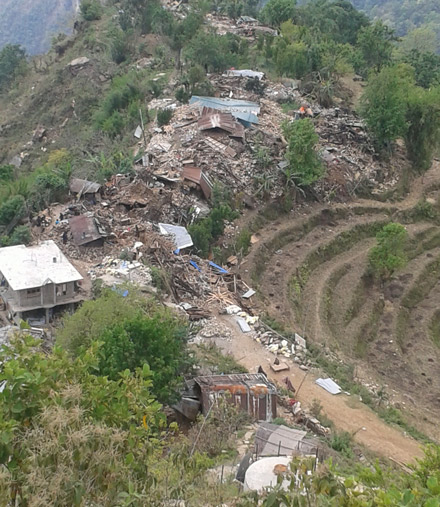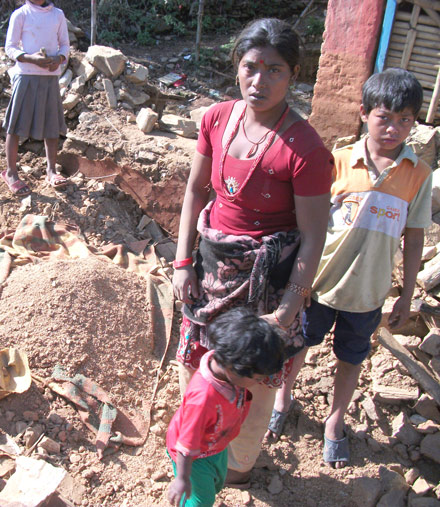Editor's note: Buddi Khatri, Heifer Nepal's senior program manager for training, tells his story about where he was during the devastaing earthquake that struck Nepal on April 25, and his experience in the ensuing weeks. He is seen in the photo above, preparing a temporary shelter where he is currently living with five other families after their houses were made uninhabitable by the disaster.
During my 11 years of work experience with Heifer, I have had the opportunity to travel to different Heifer countries and meet with wonderful people from diverse cultural backgrounds. Of all these places and people, Quito in Ecuador has to be the best place I have ever been. I travelled to Ecuador on April 2015, to conduct workshop on Heifer’s 12 Cornerstones and Training of Trainers for the Americas program. All the beautiful places and warm and friendly people filled me with inspiration. I was highly motivated to impart my knowledge on Heifer’s values to the Americas Training staff and help them apply it at the country level for social capital building. Everything was going smoothly until that black day.

The night of April 24 I had had a bad dream. The next morning I woke up with a terrible feeling. I turned on the TV to update on global news. On the screen they were showing Kathmandu completely devastated, heritage sites destroyed, buildings and roads collapsed. I struggled to understand what was happening. A massive 7.8-magnitude earthquake had struck my country, Nepal, with the epicenter in Gorkha district—my hometown. I went numb. They continued to give updates on the number of dead and injured and the damaged infrastructure. My thoughts drifted toward my family, my ancestral home in Gorkha and to all my fellow citizens who were suffering immensely. My colleagues attending the training had also heard about this and provided me much needed emotional support. But I couldn’t continue with my training. I couldn’t sleep that night. With a heavy heart, I decided to return back to my country.
It was the longest journey of my life.
On my way back, I finally got in touch with my family and found out that they were safe but that my house in Kathmandu had sunk by a few inches. Immediately after returning to Kathmandu I travelled to Gorkha. Entire villages were gone—wiped out. A place so beautiful with mountains and greenery was now just miles and miles of rubble. When I reached the village, the condition was terrible. The people had not yet received any support from government or aid agencies. Any new face in the village would be surrounded by the locals with an expectation of some sort of support or with questions on when they would receive support. But I didn’t have any answers either.

I helped build a temporary shelter for my family and neighbors by retrieving tin roof sheets, bamboo and wood from the collapsed houses. Once that was finished, I returned back to Kathmandu, as each moment I spent there was painful beyond belief, and I knew I could be more helpful with my team in the Heifer office than in Gorkha by myself.
Upon my return I immediately joined Heifer’s relief team and travelled to Dhading district, another area heavily impacted by the earthquake. The situation of the people there too was the same, dire. But the relief we have been able to distribute to more than 21,000 families in 12 districts has provided a roof above their heads to protect them from harsh weather. There is so much more to do still.
On May 12, 2015, another earthquake hit the country. I was in my office working with my team. Luckily we did not have any relief distribution that day. All our staff gathered in the office garden. Our first concern was our families. Since the telephone lines were disrupted and heavily engaged immediately after the quake, it was difficult to get connected to them. But eventually we were able to make contact. This second quake had further sunk my house, making it uninhabitable. Since then I have been camping out with my family under a temporary shelter.
We are among the lucky ones who survived the greatest tragedy the country has seen in decades. So, it is our duty to dedicate our lives to ease the sorrows of the ones who were not as lucky.
The situation is getting back to normal now as the tremors are less frequent. My heart goes out to Quito, Ecuador, to all the lovely people I left so abruptly without getting a chance to say goodbye. I am glad that my counterparts facilitating the workshop were able to complete it successfully. Even today, I look at the pictures from Quito and the people I met there and remember how drastically things have changed.
Buddi B. Khatri, Senior Program Manager – Training, as told to Alina Karki, Communication and Networking Officer